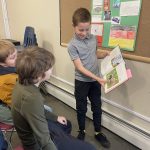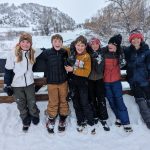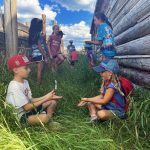Bravery Through Art
Mountain Connection, December 5, 2023
By: Jed Donnel
Each day on my trips around campus, I enjoy walking through the student art gallery. The individual pieces are inevitably engaging and thoughtful, and their variety intrigues me to consider the interesting prompts and methods that must have inspired their creation. As Lainey and Keri describe, “The art department between campuses exists to stimulate student curiosity and playfulness, to provide global connections between historical, structural and cultural perspectives, and to guide in the development of students’ own artistic voices.” Lainey acknowledges how closely their philosophies align, and it’s clear in pursuing the students’ work how talented both teachers are at the tricky combination of providing formal instruction while sustaining student’s individuality. Lainey emphasizes the creativity that all young kids possess, and she strives to help her students sustain or rediscover it, noting, “My aim is to have every student feel as though they can be successful. It’s alarming how often I hear my students say they can no longer make art. Everyone can make art, but for some reason the ‘how’ seems to disappear as we age. I just want them to find their spark again.”
Lainey centers her curricula around four major frameworks: structural, subjective, cultural, and post-modern, each of which includes exposure to a diverse array of contemporary artists and an emphasis on real-world experience and contexts. During the first trimester, students studied works from Louise Nevelson, El Anatsui, Ruth Asawa, Georgia O’Keefe, Alexander Calder, Betye Saar, Andy Goldsworthy, Roberto Benavidez, and James Morrison. As students create their own works, the emphasis is on experimentation, whether in genre, medium, process, tools, methods, or styles. Lainey adds, “We talk a lot about what art is and can be, high art vs low art, how art changes meaning when you remove it from its original context, and ways by which we assign value to it. The students learn different ways to enjoy what they create. As they find success, they want to keep doing it after they finish my class.”
For me, the results in the gallery showcase the students’ bravery and abilities to communicate interesting, personal perspectives without words. They’re clearly invested in the work itself, which Lainey fosters by including students in curating the space, as they help to determine not only what goes on display but how and where to hang the pieces. Currently, examples of photorealism brilliantly juxtapose 3-D assemblage collage and papier mache birds. For the latter, Lainey states, “it began as a little inside joke to myself. Every year, the Art Gallery of New South Wales calls for submissions to their Archibald Portrait Prize, for which the winner takes a large sum of money. I thought it would be fun to host our own portrait prize, but with birds. Papier Mache is accessible to everyone, you don’t need a lot of experience or expensive materials, and there are some contemporary artists such as Roberto Benavidez and Robert Morris who make amazingly complex papier mache projects to explore controversial, personal, and socially relevant themes. I like how such a simple tradition can have complicated outcomes. The voting was open to the whole campus, and it coincided with family weekend so that family members could vote as well. This year, we had a record number of submissions, and Axton’s Northern Flicker was a clear favorite.” Of the photorealism project, she adds, “They were our first proper drawing project of the first trimester, and they set the tone for the remainder of the work. They are time consuming, they require effort, and constant revision. The project teaches students to slow down and focus their attention deeply on observing details, practicing measurements and pencil pressure, and understanding proportion and scale. They need to take care with their drawings from beginning to end, and they learn that hard things are worth doing.”
In end-of-year feedback from the past two years, students have expressed their growing confidence within the arts. Notable comments include, “I learned how to solve problems in unique ways” and “I enjoyed how supported I felt to pursue my interests.” Every student at SMS interprets the guidelines for each art project through a lens that interests them, an opportunity that resonates in their outcomes. When you’re next on campus, be sure to take time to admire their gallery.



